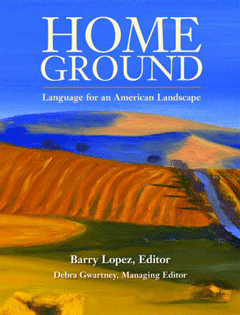The Language of Landscape
Air Date: Week of September 28, 2007

Home Ground: Language for an American Landscape, edited by Barry Lopez and Debra Gwartney.(Photo: Trinity University Press)
Living on Earth continues its series with readings from the book “Home Ground: Language for an American Landscape,” edited by Barry Lopez and Debra Gwartney. In this installment, Eva Saulitis, a writer, teacher and marine biologist from Homer, Alaska, explores the term “boreal forest”.
Transcript
GELLERMAN: It’s Living on Earth. I’m Bruce Gellerman.
[MUSIC: Daniel Lanois “O’Marie” from ‘Acadie’ (Daniellanois.com—2005)]
GELLERMAN: Imagine a landscape of a place you love. Follow the forms and the contours in your eye’s mind. Now, put yourself in the picture. To know a place, to truly know a place is a way of making it our own.
Writers Barry Lopez and Debra Gwartney asked 45 authors to describe features of different landscapes. The definitions are part of a collection found in the book called "Home Ground - Language for an American Landscape." We've asked several writers to read from their entries. Today, Eva Saulitis of Homer, Alaska and her definition of ‘boreal forest.’
SAULITIS: Boreal Forest. South of the treeless, Arctic tundra, a forest shawl wraps eleven percent of the Earth’s northern terrestrial surface. This circumpolar boreal forest is white spruce-dominated, carpeted with lichens, moss, orchids, heaths, quilted with peat bogs, and cut by cold, silty rivers. In Crossing Open Ground, Barry Lopez describes one view of this landscape: “a backdrop of hills: open country recovering from an old fire, dark islands of spruce in an ocean of Labrador tea, lowbush cranberry, fireweed…each species of leaf the invention of a different green: lime, moss, forest, jade.”

Home Ground: Language for an American Landscape, edited by Barry Lopez and Debra Gwartney.
(Photo: Trinity University Press)
Indigenous people, to this day, rely on an intimate knowledge of geography to subsist on these animals and plants. Some non-Natives also pursue this intimate geographic knowledge of the boreal forest. For several years, the poet John Haines homesteaded in the boreal forest south of Fairbanks, Alaska, hunting and trapping for subsistence, receiving the forest’s spiritual and artistic sustenance. Of this time Haines wrote, “I am living out a dream in these woods. Old dreams of the Far North.”
GELLERMAN: Eva Saulitis is a writer, teacher and marine biologist from Homer, Alaska. Her definition of ‘boreal forest’ appears in the book “Home Ground - Language for an American Landscape,” edited by Barry Lopez and Deborah Gwartney.
Links
Living on Earth wants to hear from you!
Living on Earth
62 Calef Highway, Suite 212
Lee, NH 03861
Telephone: 617-287-4121
E-mail: comments@loe.org
Newsletter [Click here]
Donate to Living on Earth!
Living on Earth is an independent media program and relies entirely on contributions from listeners and institutions supporting public service. Please donate now to preserve an independent environmental voice.
NewsletterLiving on Earth offers a weekly delivery of the show's rundown to your mailbox. Sign up for our newsletter today!
 Sailors For The Sea: Be the change you want to sea.
Sailors For The Sea: Be the change you want to sea.
 The Grantham Foundation for the Protection of the Environment: Committed to protecting and improving the health of the global environment.
The Grantham Foundation for the Protection of the Environment: Committed to protecting and improving the health of the global environment.
 Contribute to Living on Earth and receive, as our gift to you, an archival print of one of Mark Seth Lender's extraordinary wildlife photographs. Follow the link to see Mark's current collection of photographs.
Contribute to Living on Earth and receive, as our gift to you, an archival print of one of Mark Seth Lender's extraordinary wildlife photographs. Follow the link to see Mark's current collection of photographs.
 Buy a signed copy of Mark Seth Lender's book Smeagull the Seagull & support Living on Earth
Buy a signed copy of Mark Seth Lender's book Smeagull the Seagull & support Living on Earth

